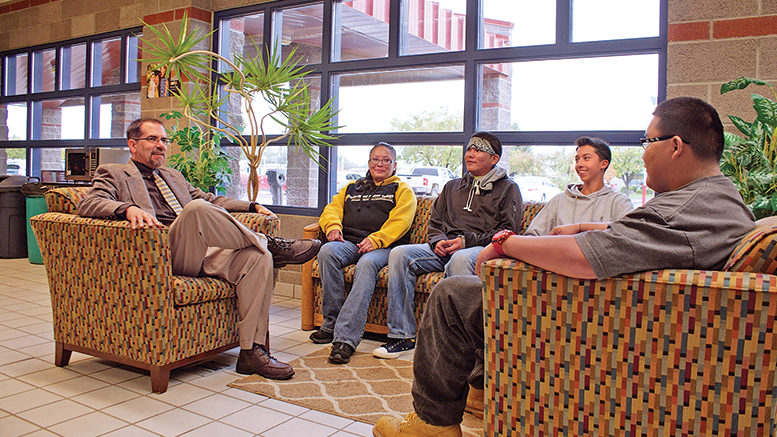In early March, Northland Pioneer College (NPC) was well into its budget planning process for the 2021 fiscal year. Leaders were getting ready to present a preliminary budget analysis to the governing board that month, so board members would have plenty of time to review the figures before voting on the budget in April.
Then, the coronavirus pandemic broke out across the U.S. The budget calendar that NPC follows was quickly cast aside as college leaders scrambled to respond to the pandemic.
This excerpt comes from the new issue of the Community College Journal, published by the American Association of Community Colleges since 1930.
The college serves Navajo County and portions of Apache County in Arizona, a geographic area roughly the size of West Virginia with a very dispersed population — about eight to 10 people per square mile. It’s also a very poor area of the country; the national educational technology group EDUCAUSE has called it a “digital desert” because of its lack of broadband access, and yet somehow the college had to shift on a dime and deliver instruction to students remotely.
NPC extended its spring break to three weeks to give faculty time to move their classes online “and also give us time to develop the support mechanisms,” says President Mark Vest.
The college’s foundation worked with its technology department to procure and distribute Chromebooks and mobile hotspots preloaded with nearly three months of internet access to students who needed them. The college also removed the password from its public wifi network and allowed students to access the internet from the safety of their cars in campus parking lots.
Back to the budget
The disruption caused by the pandemic put college leaders behind the eight ball when it came to budgeting for the next fiscal year. Some revenue sources that NPC was expecting for 2021 were suddenly in doubt, and college leaders needed time to revisit their figures.
“A number of things we would have done in March got postponed to April, and we had to ask our board to make some quick decisions so that we would remain on track,” says Maderia Ellison, vice president for administrative services and chief financial officer.
NPC’s experience certainly wasn’t unique. Amid the global pandemic, community colleges nationwide found themselves challenged like never before.
More than 21 million Americans lost their jobs in March and April. How would this economic collapse affect college revenue streams, or fall semester enrollment? Would campuses even be open in the fall? Would students continue to register for classes, or would fears of the coronavirus keep many from attending?
Budgeting for next year has had to occur “with no blueprint to follow and information changing daily,” as Joliet Junior College (JJC) President Judy Mitchell observes.
Community college leaders who are well versed in financial matters say the keys to budgeting effectively in periods of such uncertainty include being prepared to weather a crisis, being flexible in planning, staying well informed and maintaining a laser-like focus on the priorities that matter most.
Drafting a new plan
Arizona state law requires community colleges to have a final budget in place by June each year. To meet this statute, NPC typically aims to have its governing board approve a preliminary budget during its April meeting, so the budget can be posted for public comment and then revised if necessary before June.
This year, “there were challenges in trying to make sound decisions with limited data,” says Ellison, who also serves as treasurer of the Community College Business Officers (CCBO).
NPC’s leadership team held off on presenting their FY21 budget analysis to the governing board in March, so they could assess the impact the coronavirus might have on college operations first.
The new budget plan they presented to the board in April omitted state funding for rural community colleges that they learned would no longer be included in Arizona’s FY21 appropriations. It also added about $250,000 in spending to prepare campuses for reopening safely amid the pandemic, a figure that Ellison says might need to be revisited later in the year.
Instead of having a full month to review the budget analysis, the governing board voted on the plan during its April meeting. The final budget calls for $51.1 million in spending for FY21, a slight increase (0.6 percent) over the prior year’s number.
Despite a modest proposed spending increase, the college plans to cut tuition next year.
“Although we had earlier set our in-state tuition rate at $79 per credit,” Ellison says, “we went back to our board and asked that we reduce that by half, to $40, so that the pandemic didn’t become another barrier keeping students from furthering their education.”
Be prepared
To make this math work, NPC plans to tap into its substantial $45 million reserve fund, withdrawing $2 million for use in 2020-21.
After the 2008 recession, the college began setting aside money each year for emergencies as it was able to do so.

edition online.
“Our district governing board made a conscious decision to slowly create a reserve fund so that we could save our taxpayers money by building without debt when we needed to, and also smooth out the peaks and valleys of budgeting,” Vest explains.
When Ellison and her colleagues develop revenue projections for the college, they don’t include smaller revenue streams in the budget, such as money from auxiliary services. These minor sources can help close budget gaps that emerge when costs exceed expectations or fewer students enroll than anticipated — and the college can also draw upon its reserve fund to make up the difference if necessary.
NPC’s example suggests that budgeting successfully in uncertain times is a lot easier if colleges have taken steps to prepare beforehand.
Having the foresight to develop a large reserve fund has enabled NPC to face an uncertain future without compromising its core mission. “When there’s an economic downturn, and we see our revenues potentially dip, that’s when our students need us the most,” Vest asserts.

